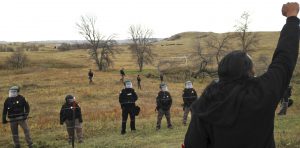The Dakota Access pipeline has become an increasingly contentious issue in the past few years, largely due to its infringement on lands in North and South Dakota where Native Americans used to live. At the surface, running an oil pipeline through currently uninhabited land seems innocuous, but Native Americans still hold that this territory is very important to their culture and spirituality. Brought in to sort out the difficult questions, archaeologists have dug deeper to find evidence of previous Native American religious sites and graves of the ancestors of living Native Americans.
Native Americans and archaeologists have relied on several pieces of legislation designed to protect the rights of Native Americans and their culturally significant historical sites and artifacts. The Native American Graves Protection and Repatriation Act (NAGPRA) and the National Historic Preservation Act (NHPA) are the two key legal documents in this battle between Native Americans in the area and the companies who own the pipeline. In particular, the Standing Rock Sioux Tribe believe that the legislation has not been followed to the fullest extent, leading to many of their identified sites being overlooked during the surveying and environmental risk assessment process.
The United States Army Corps of Engineers (USACE) states in its environmental assessment that “based on data compiled from previously executed archaeological investigations, it is recognized that much of the region [around the pipeline] has been inhabited by human populations for approximately 12,000 years” (Source 1, page 87). Despite these findings, the USACE states that “the Proposed Action is not anticipated to impact cultural resources” for the areas in question around the pipeline (Source 1, page 116).

A Dakota Access pipeline protester defies law enforcement officers who are trying to force them from a camp on private land in the path of pipeline construction
The Native Americans have focused their efforts on highlighting the negative environmental impacts that the pipeline will have on its surrounding areas, including contaminating drinking water and disturbing nearby archaeological sites through the process of constructing the pipeline. According to the Pipeline and Hazardous Materials Safety Administration in the United States Department of Transportation, there have been 2,057 pipeline incidents in the past three years, validating the concerns of the Native American tribes. However, the USACE has allowed the pipeline to progress because the owners of the Dakota pipeline have plans for minimizing the damage and environmental impact on the nearby cultural resources in case of an oil leak, and the owners have also claimed that ground disturbances are minimal during the actual construction of the pipeline.
In spite of this, archaeologists have continued to survey the areas and have determined that “the current Project Area has a moderate to high probability for archaeological deposits” (Source 1, page 87). Using these facts to empower the Native Americans fighting for their ancestors’ culture and spirituality, archaeologists have provided a new hope for the native people to reclaim their land rights. Yet the battle for cultural rights is not over, and the Native Americans need more archaeological assistance to further their case to disallow the Dakota Access pipeline to degrade their ancestors’ land.
Sources:
- http://www.nwo.usace.army.mil/Missions/Civil-Works/Planning/Project-Reports/Article/633496/dakota-access-pipeline-environmental-assessment/ (United States Army Corps of Engineers – Final Draft of the Environmental Assessment Dakota Access Pipeline Project)
- https://www.fws.gov/uploadedFiles/DAPL%20EA.pdf (Dakota Access Pipeline Project, US Fish and Wildlife Service – Environmental Assessment Grassland and Wetland Crossings)
- http://opsweb.phmsa.dot.gov/primis_pdm/all_reported_inc_trend.asp (Pipeline and Hazardous Materials Safety Administration, US Dept of Transportation *note can only be opened in Microsoft Internet Explorer 11- not 12- and Mozilla Firefox*)
- http://acra-crm.org/resources/Pictures/ACRADAPLStatement_9_28_2016.pdf (American Cultural Resources Association Statement on the Dakota Access Pipeline)
Images:
- Map of the Dakota Access pipeline (From the Source 2 PDF)
- Native American man protesting
Further Reading:



